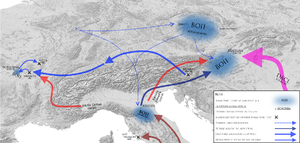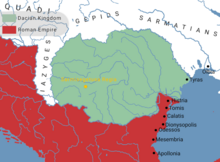Burebista
He was the first king who successfully unified the tribes of the Dacian kingdom, which comprised the area located between the Danube, Tisza, and Dniester rivers, and modern day Romania and Moldova.
These campaigns inevitably culminated in conflict with Rome in 48 BC, at which point Burebista gave his support to Pompey.
Decebalus was forced to agree to harsh terms of peace, but did not honour them, leading to a second invasion of Dacia in 106 AD that ended the independence of the Dacian kingdom.
Only few ancient sources on Burebista survive: Strabo: Geographica 7.3.5, 7.3.11 and 16.2.39 (who spells his name Byrebistas and Boirebistas); Jordanes: Getica 67 (spells his name Buruista); a marble inscription found in Balchik, Bulgaria (now housed at the National Museum in Sofia), which represents a decree by the citizens of Dionysopolis about Akornion[1] and another inscription found in Nesebar.
[2] The area roughly located between the Danube, Tisza and Dniester rivers – approximately coinciding with modern-day Romania – became home to a varied group of Thracian peoples, including the Getae and Dacians, sometime around the 7th to 6th centuries BC.
[4] Living in the lower Danube basin, the Getae were able to establish regular trade with the Greek cities along the coast of the Black Sea.
[3][4] This relative geographic isolation allowed the Dacians to survive catastrophic struggles – often with the Getae – and thrive to become the dominant tribe by the 1st century BC.
The development of a La Tène-based economy in the 3rd and 2nd centuries BC allowed the consolidation of political power through tribal unions.
Such regional unions were found among both the Transylvanian Dacians under the rule of Rubobostes and the Moldavian and Muntenian Getae in Argedava.
[7] It is from the La Tène that the Dacians were introduced to the potter's wheel, superior metal-working techniques, and probably a tradition of minting coins.
[5] There is archaeological evidence to suggest that relations between Dacians and Celts living in the areas north and west of Dacia continued.
Painted ceramics of late La Tène-style have been found in Dacian sites in west and central Dacia.
[6][4] Burebista's accession came with the expulsion of Celts around 60 BC when his forces moved through to the middle Danube region, and with the support of the religious establishment and leaders in Dacia which brought around a stricter moral code in the Dacian kingdom.
[7] The exact degree of centralization is a matter of debate, with archaeologists such as Kris Lockyear denying the existence of a state, saying the archaeological evidence shows regional diversity and only a few region-wide trends.
[11] In the Orăștie Mountains, Burebista built a system of stone fortifications on high ground; the most important of such hill forts are located today in the villages of Costești, Blidaru, Piatra Roșie, and Bănița.
These citadels, which exhibited Greek military architecture, coupled with the presence of Burebista and his armed forces, served to secure the Dacian people internally.
[4] In 60/59 BC he defeated and conquered the Boii, who were led by Critasiros, and the Taurisci tribes dwelling in the Middle Danube, in modern Bohemia and Slovakia.
[7][12][8] The Boii had established a tribal presence in the areas now occupied by eastern Austria and south-western Slovakia and Hungary sometime in 75–50 BC.
[4] Similarly, Burebista conquered a tribe that Strabo describes as living among the Illyrians and Thracians – most likely the Scordisci – while simultaneously conducting raids throughout Thrace, Roman Macedonia, and Illyria.
In the same year Caesar was assassinated, Burebista was killed in a plot by the Dacian aristocracy, who saw a centralized state as leading to a reduction in their privileges.
[26][6] The image of fearless and noble Dacians as predecessors to modern Romanians was augmented and impressed by nationalist movements in the late 1920s and 1930s.
[28] Starting in the 1970s, the Nicolae Ceaușescu regime used nationalistic and questionable interpretations of ancient history (Protochronism) to legitimize its rule.
[30] The epic movie Burebista (1980) based on the king's life was released the same year, and celebrated him as the Romanian pater patriae.
"[31] Kürti notes that similar political devices are used by Hungarians to promote their claim to the same Transylvanian region, part of Romania.






